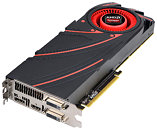Tuesday, March 4th 2014

AMD Chases Crucial $279 Price Point with Radeon R9 280
AMD's Radeon R9 200 series appears to have come a full circle with the company launching the Radeon R9 280, to capture the crucial US $279.99 price point, going against NVIDIA's GeForce GTX 760. The R9 280 isn't too different from the Radeon HD 7950 from the previous generation, featuring higher clock speeds, and PowerTune with boost. Based on the 28 nm "Tahiti" silicon, the R9 280 features 1,792 Graphics CoreNext stream processors, 112 TMUs, 32 ROPs, and a 384-bit wide GDDR5 memory interface, holding 3 GB of memory. The card features clock speeds of 827 MHz core, 933 MHz boost, and 5.00 GHz memory. The R9 280 is rated with the same 250W average board power as the R9 280X. AMD add-in board (AIB) partners have launched custom-design boards, including ones that feature factory overclocked speeds.

40 Comments on AMD Chases Crucial $279 Price Point with Radeon R9 280
if the r9 280 sells at anything like its £170 rrp then its ability to run most games at 1440p with ease alone and monstering them all with 2 in xfire for £350 will make it a hit with gamers. miners will love the kw:hash rate as they already do, only down side as they will drive up the price...i only hope the draw of maxwell will make them wait on any upgrades.
Also, it is the GTS 250 not GTX 250, and if you're including the die shrink (G92b) then that should also include the G92a/b versions of the GTS 240.Not quite
HD 7950
HD 7950 Boost
HD 8950 (OEM)
R9 280Indications coming out of Taiwan are just the opposite. 20nm looks optimized for SoC/low power GPUs and hasn't shown any tangible performance benefits over 28nm when scaled to a larger die - at least when you take into account the increased wafer cost. It is my understanding that both Nvidia and AMD will stand pat with 28nm for the performance/enthusiast segment until the 16nm FF (FinFET) derivative of the 20nm process arrives. Note how quickly the ramp of 16nm FF (16nm FEOL+20nm BEOL) is due to follow 20nm.
I just think that AMD and Nvidia are not going for another leap-of-faith with risk production. And, it’s just too early to read anything from the TSMC tea leaves at this point. Not exactly understanding that another 28mm Maxwell couldn’t be a good move, but it would hold Nvidia for a year and appears if miners became fond of it could make some good ROI.
*Yawn*
On point, "AMD chases crucial $279 price point with Radeon R9 280, retailers break their legs."
9800GTX+ -> GTS250
8800GTS -> 9800GTX(not really, 9800GTX had an enhanced PCB and newer core)
9600GT was never rebranded(not including oem) and was not a G92 either
9800GT(die strunk) -> GTS240(who cares about oem-_-)
I don't know why this comes up they both do it, let it go
nice 1 smoke, it was the gso which i was thinking of. one of the best sleeper cards they did at the time as it overclocked like stink and had plenty of mem bandwidth for high res gaming. i was trying to keep away from oem cards like the hd8000 and gts300s which also had another sticker on the same hardware too. mainly as they never hit the mass markets but they are also a great indicator of how long the market had stagnated then too.
the g92b started with the 98gtx+ giving them all the ability to run faster clocks but not by much. a good overclocking g92 would hit the same speeds as a b.